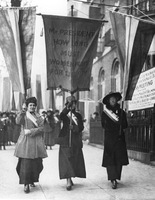 | Back to e-WV
| Back to e-WV
 The West Virginia Encyclopedia
The West Virginia Encyclopedia
 | Back to e-WV
| Back to e-WV
 The West Virginia Encyclopedia
The West Virginia Encyclopedia

In a 15-14 vote in the state senate on March 10, 1920, West Virginia became the 34th state to ratify the 19th Amendment to the U.S. Constitution, which guaranteed the right of women to vote.
Many years earlier, in 1867, just as Kansas was holding the first state referendum on women’s suffrage, or the right of women to vote, Samuel Young, a minister and state senator from Pocahontas County, introduced an unsuccessful resolution calling for the enfranchisement of women in the young state of West Virginia. Reflecting a national pattern, interest in women’s suffrage dissipated until the 1890s, when local suffrage clubs sprang up in the urban centers of West Virginia’s northern counties, with the most active clubs in Wheeling and Fairmont.
Support had increased enough by 1913 for the House of Delegates to pass a state women’s suffrage amendment, although it failed to receive the two-thirds majority needed in the Senate. Reintroduced in 1915, the amendment quickly passed the full legislature, leading to a statewide constitutional referendum in 1916. The high hopes and hard work of the suffragists were shattered, however, when the amendment failed by more than two to one, with only two of the 55 counties showing majorities in favor of giving women the vote. The suffragists blamed liquor and business interests, but voting patterns indicate that conservative social and religious beliefs were probably more influential. Anti-suffragists also had launched an effective campaign around the state.
The federal amendment for women’s suffrage passed Congress in 1919. Ignoring anti-suffrage protests, Governor John Jacob Cornwell included ratification on the agenda of a special legislative session called to address a tax question in late February 1920. The House of Delegates quickly ratified the amendment, but the Senate deadlocked. In a dramatic effort to end the stalemate, Sen. Jesse Bloch of Wheeling returned from a California vacation in a cross-country dash to break the tie. Thus, less than fours years after the disastrous defeat of the referendum for state suffrage, West Virginia’s suffragists provided a crucial victory in the fight to win the 36 states needed to achieve women’s suffrage nationally.
Written by Anne B. W. Effland
Effland, Anne W. 'Exciting Battle and Dramatic Finish': The West Virginia Woman Suffrage Movement, Part I: 18671916. West Virginia History, (1985-1986).
Effland, Anne W. 'Exciting Battle and Dramatic Finish': West Virginia's Ratification of the Nineteenth Amendment. West Virginia History, (1989).
Effland, Anne W. A Profile of Political Activists: Women of the West Virginia Woman Suffrage Movement. West Virginia History, (1990).